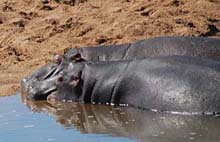Quick stats of the Hippopotamus
- Diet: – Herbivore
- Shoulder Height: – 1.45 m
- Weight: – Male – 1880 kg
- Weight: – Female – 1535 kg
- Lifespan – 40 years
Description

The Hippopotamus are the largest of the fresh water mammals. They have a very thick hide and bulky, thickset body.
The hippopotamus is most at home in water during the day, where it moves gracefully through this environment and even swims when the need arises. A hippopotamus’s head is adapted for a semi-aquatic life where the ears, eyes and nose are placed on top of the head and protrude out the water while the rest of the body is submerged. The ears and nose close automatically when submerged.

These well-rounded animals feed by night, leaving the water towards evening to forage on grass or small shrubs along the river banks, often covering considerable distances. Their dung is very easy to recognize, as they have the peculiar habit of ‘spraying’, or fanning, the dung against a shrub or tree.
Very aggressive animals
Males sometimes become very aggressive and domineering, resulting in vicious and lengthy fights, the loser of which is usually forced to leave the herd. Sharp canine and incisor teeth are situated at the front of the exceptionally large, wide mouth, and males can inflict severe wounds with these tusks.
After a gestation period of 8 months, pregnant females will give birth to a single calf.
Dowload interesting animal sound for your ringtone: ringtonesonic.com
Other Names for the Hippopotamus
- Hippo
- Seekoei
Distribution
The common hippopotamus (Hippopotamus amphibius) was primarily found in sub-Saharan Africa, with populations inhabiting a range of freshwater habitats, such as rivers, lakes, and swamps. Here is an overview of their distribution:
- West Africa: Hippos can be found in various countries in West Africa, including Senegal, Mali, Niger, Burkina Faso, Guinea, Sierra Leone, Côte d’Ivoire, Ghana, Togo, Benin, and Nigeria. They are often found in river systems and wetlands in this region.
- Central Africa: Hippos are present in many central African countries, including Cameroon, Central African Republic, Equatorial Guinea, Gabon, Republic of the Congo, and the Democratic Republic of the Congo. They are commonly found in rivers and swamps.
- East Africa: This region has significant hippopotamus populations. Countries like Kenya, Tanzania, Uganda, Rwanda, and Ethiopia have hippos living in various water bodies, including lakes, rivers, and wetlands. Lake Naivasha in Kenya, for example, is known for its hippo population.
- Southern Africa: Hippos are found in several countries in southern Africa, including Zambia, Zimbabwe, Mozambique, South Africa, Botswana, and Namibia. They inhabit rivers, lakes, and estuaries in this region. The Okavango Delta in Botswana is a well-known area for observing hippos.
- Madagascar: A unique population of hippos, known as the Malagasy hippopotamus (Hippopotamus lemerlei), is found in Madagascar. They are a separate species from the common hippo and are confined to the island’s freshwater habitats.
Taxonomy of the Hippopotamus
- Order – Artiodactyla
- Family – Hippopotamidae
- Genus – Hippopotamus
- Species – Hippopotamus amphibius







